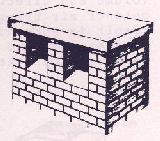|
 |
CHIMNEY TOPS
will help to protect the masonry by keeping out the rain and snow. When downdrafts from surrounding trees or tall buildings prevent proper draft, a top cover may be helpful in deflecting these air currents. The total area of the side openings should be at least four times the area of the chimney flue. Tops should be checked annually and cleared of nests or other obstructions. |
|
Never burn treated lumber in a fireplace or wood stove
'Wolmanized' lumber contains arsenic and chromium which are highly toxic. Do not use cedar shingles for kindling, they are also treated with chemicals.
|
Tuck-pointing
is frequently required for chimneys. This is not unusual and can be expected since the chimney is exposed to the weather on all four sides. |
|
.
.
.
|
| Fireplace - Exterior Components |
|
| .... |
Need more information? Use our search box
Masonry chimney. Spark arresters. Chimney cap. Chimney brace. Cricket or saddle. When to sweep the chimney.
Chimney. The chimney carries away the by-products of combustion. Each fireplace requires its own chimney flue. Clay flue liners have been installed since the 1950s. A liner will improve the draft and makes it easier to sweep.
The chimney should be supported by a footing, located below the frost line.
A safe chimney must be free-standing, receiving no support from the roof or the house.
Each fireplace and furnace must have separate flues all the way to the top of the chimney.
Flues should be separated by at least 2" (50 mm) of solid masonry.
Spark arresters also called flue caps, not only stop sparks, but also squirrels, raccoons and birds from entering. They also keep out debris and rain, which can rust out dampers.
Chimney cap. The purpose of the cap is to prevent water from entering the chimney structure where it can cause extensive damage. The cap is usually made of four flat stones, and topped with parging and should be checked annually for loose stones and missing or cracked parging. Sometimes the cap is a single unit of poured concrete.
A chimney brace may be required for tall chimneys for lateral support. Support is especially recommended for tall slender (single flue) chimneys. Not installing a brace can result in major damage to the house as illustrated.
A cricket or saddle is required for wide masonry chimneys. The saddle drains water around the chimney and can prevent a build-up of ice, snow and debris behind the chimney. Without a cricket, water may back up under the roof shingles and cause water damage to the house. |

Oops!
Someone forgot to install a chimney brace

Chimney cricket or saddle |
The clean-out and access cover are located in the base of the chimney, either outside or in the basement. The chamber should be checked before the start of each heating season. If you see twigs and leaves, you may have a blocked chimney, which is dangerous. Any obstructions should be removed immediately before the fireplace is being used.
The danger of creosote. Any wood, seasoned or not, generates creosote as it burns. Slow burning fires deposit more creosote than other fires. If the build-up is allowed to go on for a long time you WILL have a chimney fire.
Excessive creosote build-up is caused by:
- Using damp wood.
- Low chimney temperatures.
- Improper or insufficient draft.
- Smoldering fires.
When to clean (sweep) the chimney. If the fireplace is used an average of twice a week, it should be cleaned annually. If the fireplace is used more often, it should be cleaned after every 60 fires.
For more information on fireplaces go to the fireplace and wood stove index.
|
|
|